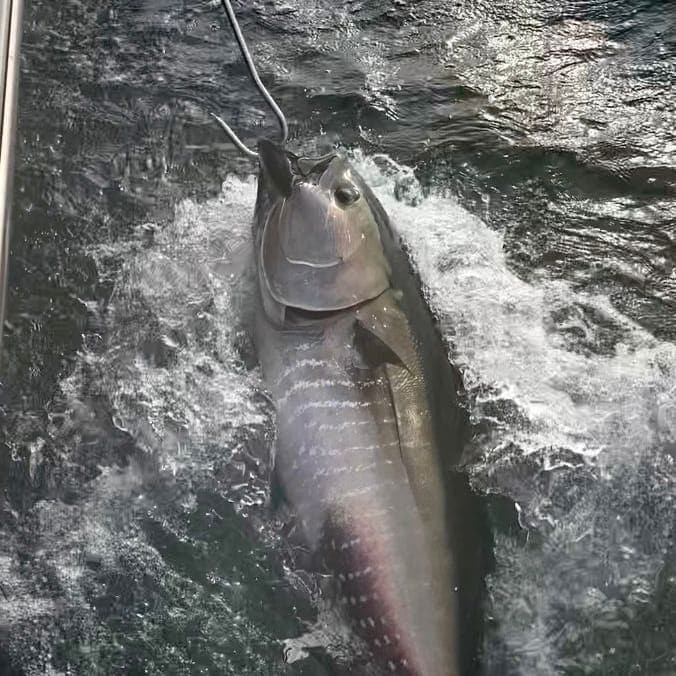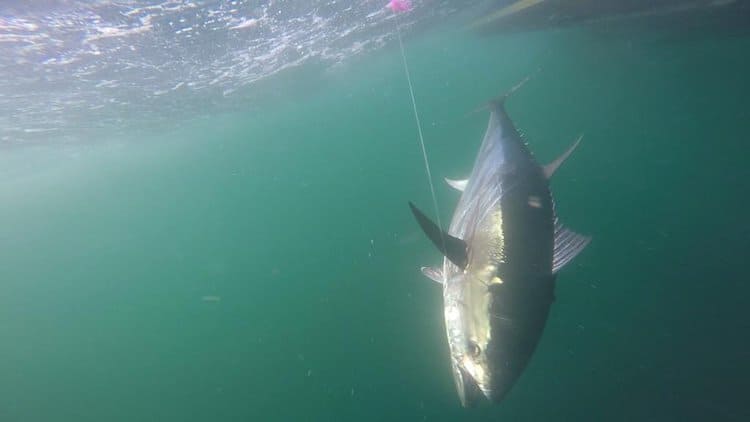Bluefin tuna are large, fast, and powerful fish, highly prized for their meat, especially in sushi and sashimi markets. There are three species of Bluefin tuna: Atlantic, Pacific, and Southern. These fish can grow to be massive, with some specimens reaching over 900 pounds and lengths of up to 10 feet. They are characterized by their dark blue top and silvery white bottom, which helps them blend into their oceanic environment. Bluefin tuna are highly migratory, traveling long distances across oceans, and are known for their incredible speed and stamina.
Bluefin tuna are primarily caught using trawling, hooking (through handlines, trolling, and longlining), and in fixed traps near the coast. However, the most prevalent method, especially in the Mediterranean, is through the use of tuna seiners. This technique accounts for more than 90% of bluefin tuna catches in that region.
Catching Bluefin tuna is an exciting and rewarding experience, but it is not easy. It requires specific gear, knowledge, and techniques due to the size, power, and speed of these fish. This guide will delve into the optimal fishing setup, the most effective baits and lures, specialized fishing techniques, the best locations to find bluefin tuna, as well as tips for beginners.
Bluefin Tuna Fishing Setup
The most common tackle to catch Bluefin Tuna involves heavy-duty gear due to the immense size and strength of these fish. Anglers typically use rods and reels that can handle the intense pressure, with reels often being 50-130 pound class to manage the power of a large Bluefin. The size of the line varies depending on the fishing method and the size of the tuna targeted, but it’s not uncommon to use line strengths of 80-130 pounds or more.
The best rig for Bluefin Tuna often involves the use of live bait rigs or artificial lures, depending on the situation and preference. A popular and effective rig is the kite rig, which uses live bait suspended on the surface to attract tuna. Another effective rig is the chunking rig, where pieces of bait are used to create a scent trail, with a hooked bait piece presented among the chum. This setup typically uses circle hooks sized from 4/0 to 9/0, depending on the bait size and the tuna being targeted. The choice of rig and bait plays a crucial role in successful Bluefin Tuna fishing, as it needs to match the feeding habits and preferences of the fish.

Best Bait For Bluefin Tuna
Bluefin Tuna have a varied diet that includes smaller fish, squid, crustaceans, and even eels, making them receptive to a wide range of baits. The best live bait for Bluefin Tuna includes mackerel, herring, sardines, and squid. These baits closely mimic the tuna’s natural prey, making them highly effective in attracting these predators. Anglers often use live bait rigged on circle hooks to ensure a higher hook-up ratio and healthier release for non-target catches.
In terms of artificial lures, Bluefin Tuna respond well to large, brightly colored poppers, stickbaits, and trolling lures that mimic the appearance and movement of their prey. Trolling lures, in particular, are effective at covering large areas of water and can be presented at varying depths to match the feeding depth of the tuna. The size and color of the lure should match the prevalent baitfish in the area to increase the chances of a strike.
Bluefin Tuna Fishing Techniques
Tuna Seiners
Tuna seiners are the most common and effective method for catching Bluefin Tuna, especially in the Mediterranean, where over 90% of the catches are made using this technique. Seine fishing involves encircling a school of fish with a large net and then drawing the bottom of the net together to trap the fish. The key advantage of this method is its efficiency and effectiveness in catching large numbers of tuna at once, making it the preferred method for commercial operations in regions where Bluefin Tuna aggregate in large schools.
Trolling
Trolling is one of the most common and effective techniques for catching Bluefin Tuna. This method involves dragging lures or baited hooks behind a moving boat. The setup typically includes heavy-duty trolling rods and reels capable of handling large fish, with lures or rigged bait attached via strong fishing line. It’s most effective in covering large areas of water to locate schools of tuna or individual fish. Trolling is particularly effective during the times when tuna are known to be actively feeding, such as early morning or late afternoon. The key is to mimic the movement of the tuna’s natural prey, with speed adjustments based on the behavior of the fish and conditions of the day.
Chunking
Chunking involves throwing pieces of cut bait into the water to create a chum line, then drifting a hooked bait within the chum to entice tuna. The setup for chunking usually involves a conventional reel on a medium-heavy to heavy rod, with a strong line. This technique is highly effective when Bluefin Tuna are feeding on baitfish schools, as it simulates a natural feeding environment. Anglers often use this method when tuna are located but not actively feeding on the surface, as the scent trail can draw them up from deeper waters.
How long does it take to reel in bluefin tuna?
The time it takes to reel in a Bluefin Tuna depends on the size of the fish. Generally, the process can take anywhere from 30 minutes to several hours.
- Small to Medium Bluefin Tuna (under 200 pounds) can often be brought to the boat within 30 minutes to an hour, especially if the angler is experienced and using appropriately heavy gear.
- Large Bluefin Tuna (200-500 pounds) fight might last between 1 to 3 hours, requiring significant effort and expertise to successfully land the fish.
- Giant Bluefin Tuna (over 500 pounds) can battle for over 3 hours, and there are instances where anglers have fought these massive fish for over 6 hours.
Tips To Catch Bluefin Tuna For Beginners
- Start with a heavy-duty rod and reel combo capable of handling 50-80 pound test line to withstand the strength of Bluefin Tuna.
- Use a conventional reel for easier handling and control during the fight.
- Opt for a simple trolling setup with feathered jigs or cedar plugs, as these are easy to use and effective in attracting tuna.
- The best bait for beginners is frozen squid or mackerel, as they are readily available and appealing to tuna.
- Rig your bait with a circle hook (size depending on bait size) to increase the chance of a good hook set and to facilitate easier release if needed.
- To setup a hook with bait, thread the bait onto the hook through the hardest part of its body (for squid, through the mantle; for fish, through the nose or the back) to ensure it stays on during casts or trolling.
- Use a leader of fluorocarbon or monofilament between the main line and the hook to make the setup less visible to the fish. A length of 6-10 feet and strength of 80-100 pounds is a good start.
- Practice tying a secure knot to connect the hook to the leader, such as the Palomar knot or the Improved Clinch knot for reliability.
- Be patient and prepared for a potentially long fight; Bluefin Tuna are known for their strength and stamina.
- Consider hiring a charter or going out with experienced anglers for your first few trips to learn the ropes and increase your chances of success.
Where can you catch Bluefin Tuna
Bluefin Tuna, known for their migratory nature, can be found in various parts of the world’s oceans, primarily in temperate and subtropical waters. Here are some notable regions where Bluefin Tuna can be caught:
North Atlantic Ocean
One of the most popular areas for Atlantic Bluefin Tuna is off the coast of New England, including Massachusetts, Maine, and Rhode Island, particularly during the summer and fall months. The Gulf of Mexico is also a significant breeding ground for Bluefin Tuna, though fishing here is highly regulated.
Mediterranean Sea
The Mediterranean is renowned for its Bluefin Tuna, especially for large specimens. Countries like Spain, Italy, and Malta are popular for Bluefin Tuna fishing, particularly in the late spring and early summer.
Pacific Ocean
Off the coasts of California and Baja California in Mexico, Pacific Bluefin Tuna can be found, especially from late spring through early fall. Further offshore, places like the San Diego area are known for their Bluefin Tuna runs.
Southern Hemisphere
In the Southern Hemisphere, places like the waters off New South Wales in Australia and parts of New Zealand see migrations of Southern Bluefin Tuna, particularly during the summer months of that hemisphere.
How to find Bluefin Tuna in Deep Sea
Finding Bluefin Tuna in the deep sea involves understanding their behavior, migration patterns, and the environment they prefer. Bluefin Tuna are pelagic fish, meaning they inhabit the open ocean, often in deep waters. They can dive to depths of 500 to 1,000 meters, and sometimes as deep as 3,000 feet. They tend to follow temperature breaks and currents that concentrate their prey, such as smaller fish and squid. Anglers often look for signs such as birds diving (indicating baitfish), surface disturbances, and changes in water temperature or color that may indicate the presence of Bluefin Tuna below.
A fish finder is an essential tool in locating Bluefin Tuna in the deep sea. It uses sonar technology to provide images of the water column beneath the boat, showing structures, baitfish, and potential predators like tuna. Advanced fish finders can differentiate between species, sizes, and even show the direction of fish movement. For targeting Bluefin Tuna, a fish finder with a powerful transducer, capable of sending and receiving signals at great depths, is crucial. Features like CHIRP sonar, which emits a continuous range of frequencies for more detailed images, and GPS mapping, for marking successful fishing spots, are also beneficial.
When it comes to the best saltwater fish finder for Bluefin Tuna, look for models that offer high-resolution displays, powerful deep-water scanning capabilities, and the ability to integrate with other navigational tools like radar and autopilot systems for tracking and staying on top of schools of fish. Brands like Garmin and Humminbird are known for their advanced saltwater fish finder that meets these criteria.

